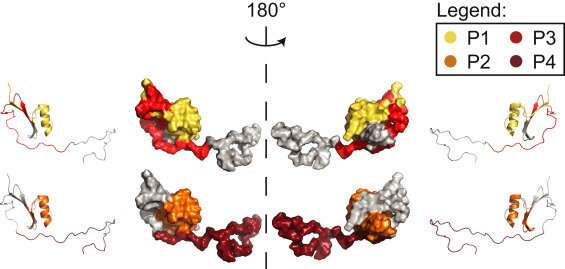Researchers discover mechanisms of mugwort pollen allergy, first step toward vaccine

A research team at MedUni Vienna has discovered key mechanisms of allergy to pollen from the common weed mugwort, thereby also laying the foundation for the development of the world's first vaccine. Mugwort (Artemisia vulgaris) poses a serious problem for allergic individuals in our latitudes from July through to September. Currently, the symptoms, which often lead to asthma, can only be treated symptomatically. The recent findings are an essential first step toward causal therapy and the prevention of mugwort pollen allergy. The landmark study has now been published in the Journal of Allergy and Clinical Immunology.
In their preclinical research, the scientists started at the point of origin of mugwort pollen allergy. They discovered where and how the immunoglobulin E (IgE) type antibodies detect the major mugwort pollen allergen (Art v 1) and trigger the exaggerated immune response. They also found that distinct protein building blocks of the main mugwort pollen allergen are in such a configuration that they can be blocked by IgG (immunoglobulin G) antibodies.
These findings by the research team led by Maja Zabel and Winfried Pickl, in collaboration with Rudolf Valenta's research team (all from MedUni Vienna's Center for Pathophysiology, Infectiology and Immunology), created the basis for the development of a vaccine against mugwort allergy: "Our study shows how fragments of the major mugwort pollen allergen can be used for effective and safe therapy," says study leader Winfried Pickl. "Our observations of the mode of action of the vaccine show that one of the ends of the main mugwort pollen allergen provides important docking sites for the pathogenic IgE antibodies of allergic individuals, which can be used for creating a novel vaccine," Winfried Pickl elaborates.
The first author of the study is Maja Zabel, who conducted the work during her Ph.D. studies at the MedUni Vienna as part of the FWF-funded doctoral program "Molecular, Cellular and Clinical Allergology, MCCA." This program is now part of the Danube Allergy Research Cluster (Danube ARC).
Widespread in the Northern Hemisphere
Mugwort is widespread in the Northern Hemisphere, where its pollen causes discomfort and even asthma in sensitized individuals from July through to September. The only treatments available to the approximately 10% of the population who are sensitive to mugwort are limited to symptomatic relief.
The current MedUni Vienna study is a first step towards causal therapy and prevention. "Next, we will use our research results to produce a synthetic vaccine that can be evaluated in a clinical trial," explains Rudolf Valenta, outlining the next step on the path to developing an effective vaccine.
More information: Maja Zabel et al, Art v 1 IgE epitopes of patients and humanized mice are conformational, Journal of Allergy and Clinical Immunology (2022). DOI: 10.1016/j.jaci.2022.04.031



















